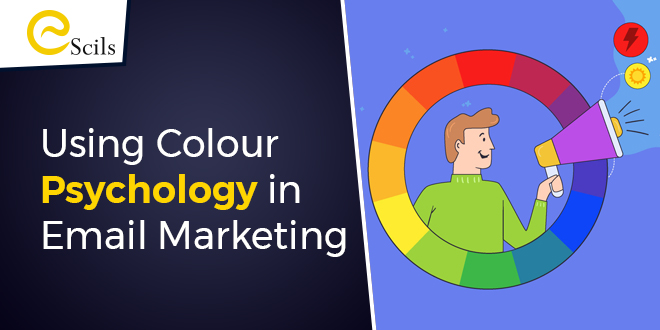Colour influences many aspects of our daily lives, including the clothes we wear, the food we consume, the walls surrounding us, and the objects we buy. If you don’t like the colour of a shirt, you can return it to the store. You’re producing nail paint if it doesn’t match your skin tone. It’s not coming home with you if the couch doesn’t fit your colour scheme.
So it stands to reason that if your email marketing uses too much colour, whether it’s too bright, too drab, or just too much, you won’t get the click-throughs you want. This is where applying colour psychology to your email marketing efforts can help.
When people make assumptions and hasty judgements, colours account for up to 90% of the decision. The problem is that no one has a universal colour choice. Personal preferences and even cultural background have a role in choosing which colours to wear. The idea is to use email marketing automation software to appropriately segment and personalise emails in order to enhance the possibilities of exposing that purple bag to people who like purple.
What Is Colour Psychology?
The science of how colour influences human behaviour is known as colour psychology. It’s a subset of the more considerable discipline of behavioural psychology. In practice, colour psychology is the study of how colour influences human behaviour and responses. Based on the colour of your material, call-to-action-buttons, and links, the psychology of colour can affect how your customers respond to your marketing message. It’s all part of getting to know your customers. Colours, on the other hand, do not affect everyone in the same way. This means there are no guarantees about its conversion or branding impacts.
However, there are some broad principles for how the majority reacts to certain hues. Here are some ideas on how to make the most of colour psychology in email marketing.
1. Make your CTA buttons stand out by using different colours.
The most prominent aspect of your email copy should be your CTA. In addition to size and positioning, colour significantly impacts whether or not readers notice your CTA. Always use a different colour than the remainder of your email. To accentuate the CTA, add a large amount of white space surrounding the button. The button’s wording and colour fill should also be contrasted. IN THE EXAMPLE BELOW, the CTA from Pinterest is a real attention grabber, with its vivid red surrounded by plenty of white space.
2. Keep your brand’s visual style in mind.
Image source: Digital Synopsis
You send a message with the colours you choose. Stick to your brand’s colour scheme to build brand trust and awareness. If you have to insert images with colours that aren’t in line with your scheme, make your hues stand out from the rest of the prose to balance it out. PayPal’s email below used their brand’s primary colour, blue, to significant effect. As you can see from the first table, blue symbolises trust, which is critical for a corporation dealing with money. The picture’s hues are neutral. The overarching theme is still white and blue, which symbolises stability and reliability.
3. The proper colour complements your company’s individuality.
Colours have a significant impact on purchasing intent because of their effect on how a brand is viewed; colours influence how shoppers perceive the “personality” of the brand in the issue. While some colours are associated with specific traits (e.g., brown is associated with toughness), nearly every academic study on colours and branding will tell you that it’s far more important for colours to support the personality you want to project rather than trying to align with stereotypical colour associations.
4. Use the most appropriate hue for the gender of your target audience.
Blues are traditionally associated with men, while pinks are associated with women; however, the color’s femininity and masculinity are not absolute. One study looked at how men and women react to different colours. Blue is the preferred hue for both men and women, according to the findings of the survey. Soft shades are preferred by women, while men prefer bright colours. Men, in general, prefer achromatic colours like black, white, and grey. Furthermore, brown is the least popular colour among males, while orange is the least popular among women.
5. Simplicity is Essential
To make your email stand out, it’s tempting to use a lot of colours. However, when it comes to email marketing, less is sometimes more. The most well-known brand logos are the ones with the most basic colour and design. The leading brands use only one colour. The majority of them use blue because it is the most popular colour among both men and women.
6. Keep in mind: Conversion is complicated by colour.
Yes, you’ll want designer input, but don’t allow them to pick the colours for your website. You’re searching for a colour scheme that converts, not just something that looks good. To enhance your conversions, you should be strongly involved in the colour choices of your landing pages. It’s critical to consider your customers’ colour preferences when designing your emails. Consider A/B testing to evaluate which combinations perform better if you’re not sure what your customers find appealing.
Here are a few more guidelines to remember:
- Stick to three colours in your email newsletters to avoid overcrowding.
- Stick to your business colours if you’re wary of coming up with new colour combinations for every email.
- Is your email visually appealing? Are there any colours that mix in? Is the text causing you to squint?
- Make use of colour on purpose: Brilliant hues capture attention, while neutral or darker colours relax.
- Use naturally existing, complementary colour combinations like pastel blue and pink or warmer yellow and orange tones if you’re unsure which colour combinations will work.
More effective emails and happier consumers will result from including the proper colours in your email marketing approach. Remember that colour affects mood, so getting it right will result in more opens, click-throughs, and sales.
Conclusion
It’s easy to miss colour psychology’s possibilities. The colour you choose for your website, branding and marketing, on the other hand, may have a more significant impact than you anticipate. Take an active role in selecting your colour scheme rather than leaving it to a designer. You are the only one who knows what you want your website to say and what you want your visitors to do when they come. For example, if you’re going to enhance conversions, you could employ hues like reds, blues, and orange. However, keep in mind that colour psychology does not guarantee results and that the same colours will not affect everyone.


